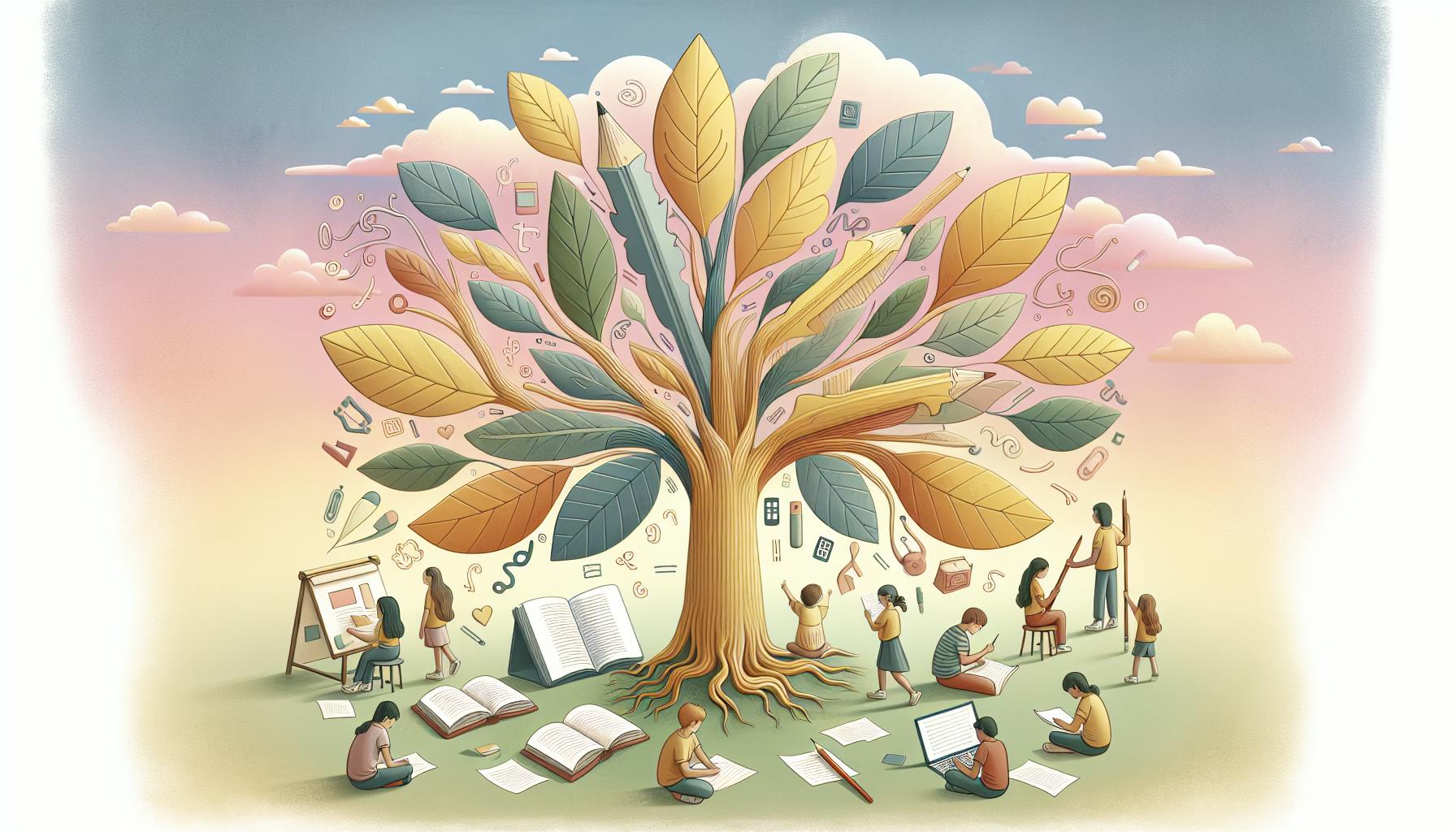Want to get students off their phones and into learning? Here's what works in 2024:
| Activity Type | Impact |
|---|---|
| Interactive Tools | Students 2.5x more likely to get top grades |
| Collaborative Work | Teams learn faster and retain more |
| AI-Powered Learning | Custom paths boost test scores above average |
| Multi-Style Teaching | Matches how each student learns best |
4 proven ways to boost engagement:
- Interactive Tools
- Pear Deck: Live Q&A in slides
- Edpuzzle: Video learning with checkpoints
- Prodigy Math: Learning through gameplay
- Team Platforms
- Google Classroom: Real-time group work
- 360Learning: Peer teaching ($8/student)
- ezTalks: Virtual team projects
- AI Learning
- Squirrel AI: Adjusts difficulty live
- Century Tech: Brain-based tracking
- Custom paths based on progress
- Learning Styles | Style | Best For | Top Tools | |-------|----------|-----------| | Visual | Charts, maps | Let's Draw | | Audio | Discussions | My Instruments | | Reading | Text, notes | Word Hunt | | Hands-on | Movement | Giant Dwarf |
Bottom line: Mix these methods based on YOUR class. When students get choices and feel heard, they join in. Let's dive into the details.
Interactive Tools
Here are 3 tools that transform passive learning into active engagement:
1. Pear Deck + Google Slides
This combo turns standard slides into interactive sessions. Teachers drop questions and activities directly into their presentations. Students jump in with answers while teachers watch the responses pop up in real-time.
| Feature | What It Does |
|---|---|
| Live Responses | Shows which students need extra help |
| Drawing Tools | Lets students draw or solve problems |
| Anonymous Mode | Boosts participation from quiet students |
2. Edpuzzle
This tool makes video watching active, not passive. Teachers insert questions at key moments, so students can't just hit play and tune out.
| Feature | What It Does |
|---|---|
| Built-in Questions | Students must answer to watch more |
| Progress Tracking | Shows who watched and understood |
| Auto-grading | Cuts grading time by 5+ hours per week |
3. Prodigy Math
Think of it as math practice disguised as a video game. Students solve problems to level up their character in a fantasy world.
| Feature | What It Does |
|---|---|
| Skill-based Levels | Matches problems to student ability |
| In-game Rewards | Makes math practice feel like play |
| Progress Reports | Pinpoints skills that need work |
"When students use AI to craft their own study experiences, they are more engaged and motivated to learn the content." - U.S. Department of Education, 2023
These tools work because they flip the script: Students become active players instead of passive observers. Teachers also get a clear picture of who's on track and who needs a helping hand.
2. Collaborative Platforms
Here's what you need to know about the top platforms students use to work together online:
1. Google Docs + Classroom
Google combines two powerful tools that let students edit work together in real-time. Teachers can jump in, leave notes, and see who's doing what.
| Feature | Benefit |
|---|---|
| Real-time Editing | Students write and fix together |
| Comment System | Fast peer feedback |
| Access Control | Teachers manage who gets in |
| Cost | Free to start |
2. 360Learning
This tool turns solo learning into team projects. Instead of working alone, students talk about topics and solve problems as a group.
| Feature | Benefit |
|---|---|
| Comment Feed | Students teach each other |
| Interactive Tasks | Team problem-solving |
| Progress Tracking | Shows team activity |
| Price | $8/month per student |
3. ezTalks Meetings
Think regular classes, but online. Students see each other, share their work, and team up on projects from their computers.
| Feature | Benefit |
|---|---|
| Video Conferencing | See and talk to classmates |
| Screen Sharing | Show work instantly |
| Group Rooms | Break into smaller teams |
| Resource Sharing | Pass files back and forth |
"By 2028, team collaboration software will hit $40.79 billion. And by 2024, only 25% of team talks will happen face-to-face."
Here's what matters: Students who work together online do better in their courses. When they talk in small groups, they pay more attention to their classmates' ideas. This makes them feel like part of the team and gets them more excited to join in.
sbb-itb-bb2be89
3. Personalized Learning
Here's how schools use AI and smart tools to help students learn better:
AI Makes Learning Personal
Two platforms are changing how students learn: Squirrel AI and Century Tech. They build custom K-12 learning paths that match each student's speed and style.
Here's what makes them different:
- Squirrel AI changes lesson difficulty on the spot
- Century Tech uses brain science to track how students learn
- Both make sure students get each concept before moving on
| Platform | What It Does | Main Focus |
|---|---|---|
| Squirrel AI | Adjusts lessons in real-time | K-12 subjects |
| Century Tech | Uses brain science for tracking | Progress checks |
| Owlift | Looks at student data | Custom content |
Students Pick Their Path
Students get to choose HOW they show what they've learned. Think of it like a menu with four options:
- Make a video
- Write about it
- Give a talk
- Draw it out
| Learning Style | What Students Do | How It Helps |
|---|---|---|
| Visual | Make charts or maps | See ideas clearly |
| Written | Write essays | Explain in detail |
| Verbal | Give talks | Share out loud |
| Hands-on | Build projects | Learn by doing |
Setting Goals That Work
The Gates Foundation found something big: When students set their own goals and watch their progress, their test scores shot UP. They went from below average to ABOVE the national average in both math and reading.
| What to Do | How to Do It | Why It Matters |
|---|---|---|
| Check Level | Test current skills | Know where to start |
| Make Plans | Pick clear targets | Know where to go |
| Keep Track | Watch progress | Stay focused |
| Fix Course | Change goals if needed | Keep improving |
"Students who used custom learning plans in math and reading didn't just catch up - they passed the national average." - Gates Foundation
4. Learning Styles
The VARK model breaks down how students learn into four main ways:
| Learning Style | What Works | Top Tools |
|---|---|---|
| Visual | Charts, maps, pictures | Let's Draw, Tangram |
| Auditory | Discussions, audio | My Instruments, Audio Numbers |
| Reading/Writing | Notes, text | Word Hunt, Synonym Antonym |
| Kinesthetic | Movement, practice | Giant Dwarf, Find 10 |
Here's what each type of student needs:
Visual learners LOVE seeing information. They learn best with:
- Color-coded notes
- Flashcards with pictures
- Diagrams and charts
Auditory learners need to HEAR it to learn it:
- Group discussions
- Voice recordings
- Talking through problems
Reading/Writing learners want to see the WORDS:
- Written notes
- Text-based materials
- Lists and bullet points
Kinesthetic learners need to MOVE to learn:
- Hands-on activities
- Physical movement
- Practice exercises
| Learning Style | Key Signs | Teaching Tips |
|---|---|---|
| Visual | Doodles during class | Use more diagrams |
| Auditory | Speaks to solve problems | Add group talks |
| Reading/Writing | Makes detailed notes | Provide written guides |
| Kinesthetic | Moves while learning | Include active tasks |
LessonBud's AI matches activities to each learning style. Teachers can create custom tasks fast - keeping every student engaged in ways that work for them.
Conclusion
Here's what works for student activities in 2024:
| Activity Type | Key Benefits | Success Metrics |
|---|---|---|
| Think-Pair-Share | Gives quiet students time to process | 30+ seconds of think time boosts participation by 85% |
| Skills Groups | Matches content to student level | Students work 40% longer |
| Student Teaching | Builds mastery through explanation | 75% better content retention |
| Anonymous Q&A | Removes speaking anxiety | 2x more questions asked |
Let me break this down into three main points:
1. Mix Up Your Teaching
Keep lessons short (10-15 minutes) and chunk your content. Switch between:
- Group work
- Solo practice
- Class talks
- Hands-on work
2. Add AI to Your Toolkit
AI helps you:
- Make custom content
- Check student progress
- Spot learning gaps
- Pick the right activities
3. Put Students First
| Participation Type | How It Works | Impact |
|---|---|---|
| Silent Input | Polls, sticky notes | Full class participation |
| Student Teachers | Jigsaw activities | 90% master the content |
| Moving Groups | Gallery walks | Students talk 3x more |
| Student Choice | Pick-your-project | 70% more students finish |
"When students feel heard and get support in different ways, they jump into learning." - Katie Martin
What's next for 2025? We'll see:
- AI that fits each student
- More focus on student wellbeing
- Better ways to track who's engaged
- New participation metrics
Here's the bottom line: Give students activities that fit THEIR needs. When they get choices and their voice matters, they'll want to join in.
Mix these methods based on YOUR class. Try stuff out. Watch what works. Your students will tell you what's best through their actions.

